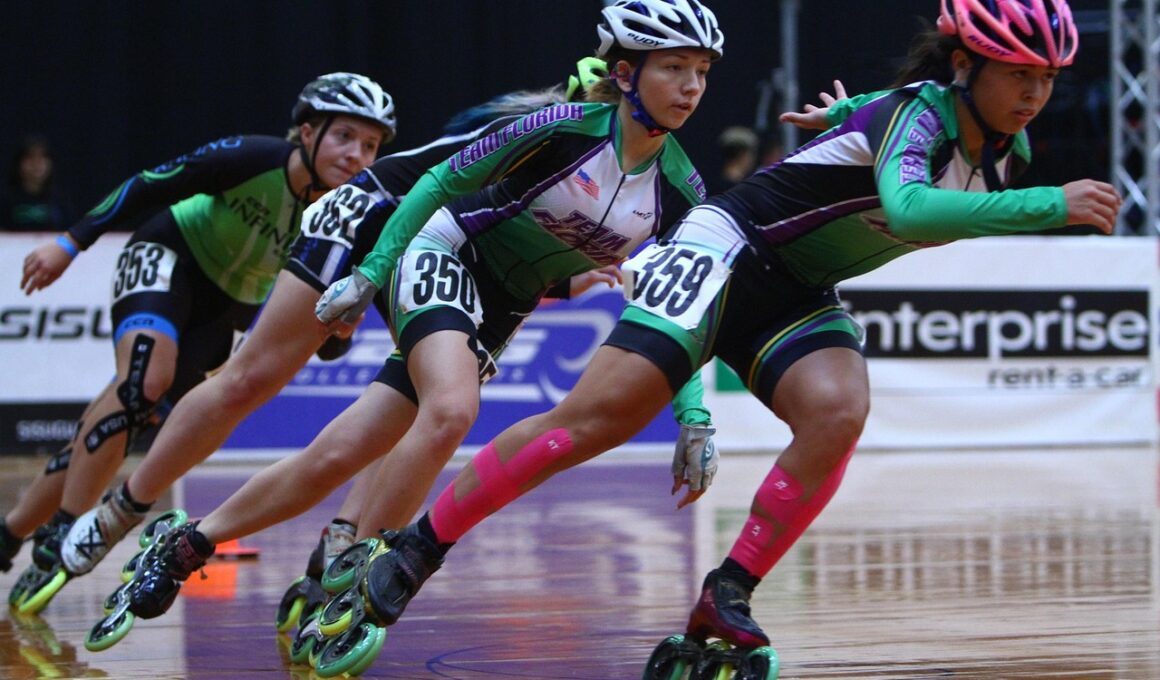The Effect of Inline Skating Speed on Injury Frequency
Inline skating is an exhilarating sport enjoyed by many across the world. However, with excitement comes the risk of injury. The frequency of injuries in this sport significantly correlates with the speed at which skaters operate. Understanding this relationship is crucial for developing appropriate safety measures and training programs. Higher speeds increase the risk of falls and accidents due to factors like loss of control and diminished reaction time. Proper protective gear such as helmets, wrist guards, and knee pads can greatly mitigate injury risks. For beginners, controlling speed is essential, and gradual progress can help in skill development while maximizing safety. Coaches should emphasize techniques that prioritize safety, encouraging skaters to practice at slower speeds initially. Additionally, environmental conditions, such as the skating surface and weather, also play a role in injury occurrence. Adaptations in skating routines can further increase awareness of surroundings. The knowledge of speed limitations and their correlation with injury frequency can empower skaters to enjoy the sport with reduced risks.
Experts agree that speed is a major factor influencing the type and severity of injuries sustained while inline skating. Injuries can range from minor abrasions to serious fractures or head injuries, directly related to the skater’s speed at the moment of impact. Skaters should be educated on the importance of understanding their limits and how speed affects control and balance. Many factors can affect a skater’s decision-making speed, including environmental elements. Skating at high speeds on uneven surfaces amplifies chances of accidents. Consequently, emergency response measures should be another consideration among skaters. Leaning critical skills such as falling safely can be instrumental in minimizing injury severity. Regular practice helps reinforce injury-prevention techniques that align with maintaining control at various speeds. Additionally, group skating initiatives can promote safer speeds among peers, as skaters often influence one another. Coaches or instructors should provide guidance on how to assess environments and skating conditions effectively, ensuring skaters understand speed-based implications. With awareness, athletes can develop prudent skating habits that significantly reduce the risks associated with inline skating.
Speed and Control in Inline Skating
Control is vital in inline skating and is directly impacted by speed. As skaters increase their pace, the margin for error decreases, which can lead to disastrous outcomes if they are not prepared. Skaters often need to master braking techniques to accommodate changes in speed effectively. Techniques such as the T-stop and plow stop are essential skills that must be mastered to enhance safety. Practicing these techniques at increasing speeds will build confidence and control, allowing skaters to react adequately when needed. Furthermore, it’s advisable to practice in safe environments devoid of obstacles or distractions initially, where quicker speeds can be controlled more easily. Safety should always be the priority, and encouraging gradual speed increases helps build both skills and confidence. Regular drills focusing on fast stopping and maneuverability will prepare skaters for unexpected situations. Working with trained professionals who understand speed management can also be beneficial. Skaters who are well-versed in controlling speed effectively enjoy longer, safer skating experiences that instill fun while reducing injuries.
One of the most overlooked aspects of inline skating speed is its psychological effect on skaters. Many individuals tend to overestimate their capabilities, leading them to skate at speeds that exceed their skill levels. Fear can manifest when approaching high speeds, influencing decision-making in critical moments. Consequently, crash rates tend to increase as skaters panic, which often results in falls or injuries. Educating skaters about their limits and encouraging self-awareness fosters a healthier approach to speed management. Mental preparation strategies can help alleviate fears and aid skaters in understanding how to handle speed-related situations. Various drills can be employed to facilitate better judgment while skating, reinforcing control at gradual speeds before progressing. Additionally, peer support and reassurance play important roles in nurturing a positive environment wherein skaters feel comfortable sharing their concerns about speed. In competitive settings, it’s essential that athletes prioritize safety over speed, as competitive excitement often skews perception. The promotion of mental well-being concerning speed awareness is a powerful tool that can significantly reduce the incidence of inline skating injuries.
Preventive Measures and Training
Preventing injuries in inline skating, especially related to high speeds, involves a multifaceted approach. Training regimens should incorporate strength-training exercises that enhance muscle support, balance, and agility. Stronger muscles can manage the physical demands of skating at higher speeds. Emphasizing endurance is also essential, as fatigue can impair reaction time leading to potential accidents. Proper warm-ups and flexibility training will prepare the body adequately for the sport, reducing injuries significantly. Regular assessment of skaters’ skills and speed management capabilities ensure they are adequately equipped before permitting them to skate at higher speeds. Attending workshops or seminars on injury prevention can further enrich knowledge. Safety measures should also involve maintaining equipment in optimal condition, ensuring that wheels, brakes, and frames are regularly checked. Roller rinks and actual skating venues should provide consistent information on safety regulations. Riders should promote awareness regarding their surroundings, bearing in mind that obstacles can appear unexpectedly. All these combined measures can create a supportive environment that encourages progress while reducing the risk of injuries, allowing skaters to enjoy the sport to its fullest safely.
The use of technology can also play a significant role in reducing injuries related to inline skating speed. Wearable devices that track speed, distance, and performance analytics can provide skaters with valuable feedback on their skating habits. This feedback can aid in understanding pace, encouraging responsible choices regarding acceleration and deceleration. Furthermore, these devices can help users set personal goals that encourage safer practices. Implementing sensors on skate gear to alert users of approaching dangerous speeds can also greatly foster safe skating among users. Partnerships between skating schools and technology companies can lead to the development of innovative solutions aimed at injury prevention. In addition, incorporating virtual reality training can prepare skaters for high-speed scenarios within controlled environments while mitigating the risks associated with real-world execution. Overall, the introduction of modern technologies can offer proactive measures to help anticipate potential hazards. By embracing technology and combining it with education and proper training, skaters can significantly lower injury rates while enjoying the thrill associated with inline skating.
The Future of Inline Skating Safety
As inline skating evolves, the emphasis on safety must grow alongside it. Future developments in materials for protective gear could lead to more effective cushioning and injury prevention strategies. Increased collaboration between health professionals and inline skating organizations will facilitate the creation of comprehensive safety guidelines tailored to different skill levels and styles. Research on speed-related injuries will continue to inform best practices and prevention techniques, ensuring that skaters can participate in the sport without unnecessary risks. Moreover, exploiting advancements in technology effectively will further ensure that inline skating remains a safe sport, attracting new participants. Community initiatives emphasizing skating etiquette, environmental awareness, and personal safety protocols will help foster responsible skating culture. By focusing on education and skill development, young skaters can be equipped to understand risk management concerning speed more effectively. Through partnerships among local communities, skate parks, and educational institutions, safer environments will be created. Regulations may introduce speed restrictions in busy public areas to protect both skaters and pedestrians. Ultimately, a collective effort from all stakeholders will shape the future of inline skating safety.
In summary, managing speed effectively is critical in lowering injury rates in inline skating. Understanding the intricate relationship between skating speed and risk empowers skaters to make informed choices while practicing this activity. Incorporating training, mental preparedness, and technological resources can elevate safety levels significantly. Through proper training techniques with a focus on speed control, skaters can gain confidence and improve injury prevention. As more research emerges regarding inline skating injuries, the strategies to counteract these risks will also become more robust. Overall, instilling a culture of safety in the skating community will foster a better environment for both novices and experienced skaters. Ultimately, inline skating should be celebrated as a fun and thrilling sport while prioritizing the health and safety of its participants. By recognizing the crucial role of speed management in relation to injuries, stakeholders in the skating community can work hand in hand to promote a safer skating experience for everyone. With collaboration and commitment from all involved, the exciting world of inline skating can continue to flourish amidst increased safety awareness.


